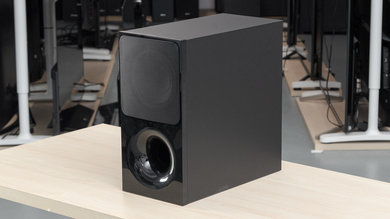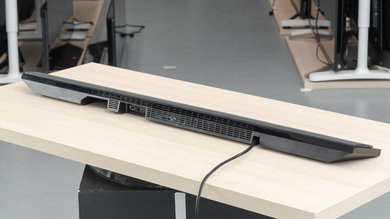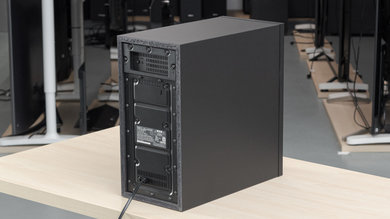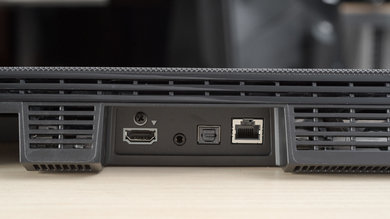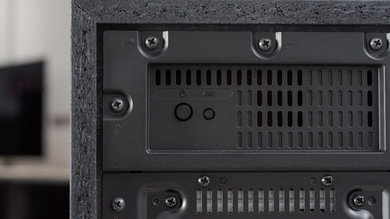The Sony HT-CT800 is a sub-par sounding soundbar that doesn’t perform well for most uses. Its sound profile is noticeably bright and lacks a lot of bass, even if this 2.1 setup has a wireless subwoofer. It can get decently loud, but you’ll get audible compression artifacts, especially in the bass range. There are also rattles coming from the sub when listening to it at a normal listening volume, which becomes even worse at a higher volume. On the upside, its angled design helps widen the vertical size of the soundstage and it's very well-built. It also has great connectivity options, both wired and wireless.
Our Verdict
Sub-par for mixed usage. The Sony HTCT800 doesn’t sound very good overall and doesn’t have a specific use where it performs very well. Its sound profile is bright and lacks a lot of bass, even if it has a subwoofer. On the upside, there are a few features to help you get a better sound with stereo content, but it won’t be the best option for movies as it lacks height channels. However, the bar sits at an angle, firing towards the ceiling, which gives a feel of a vertically larger soundstage.
-
Well-built design.
-
Vertically larger soundstage due to angled design.
-
Great connectivity options.
-
Sub-par stereo audio quality.
-
Noticeable distortion, especially at high volume.
-
Bad surround sound performance.
Mediocre for dialogue and TV shows. The Sony HTCT800 has a very bright sound profile and doesn’t sound that great overall. On the upside, it has a decent mid-range performance and can get fairly loud. You can also easily play content like podcasts and audiobooks wirelessly thanks to its Bluetooth and Wi-Fi compatibility. It also has a dialogue enhancement and auto-volume features to make your overall experience slightly better.
Mediocre for music. The Sony HTCT800's stereo frequency response performance is sub-par, as it lacks a lot of bass. This soundbar won’t be great for bass-heavy music genres as its sound profile is noticeably bright. On the upside, the soundstage is decently wide, but when pushed at high volumes, the bar compresses and distorts a lot, which isn’t good.
The Sony HTCT800 is sub-par for movies. Although this bar sits at an angle and fires toward the ceiling, resulting in a vertically larger soundstage, it still lacks a proper frequency response and height channels. This soundbar sounds very thin, bright, and lacks a lot of bass, which isn’t good for movies. While it gets decently loud, you won’t be able to push the soundbar to high volumes as it distorts and you get compression, especially in the bass range.
- 6.5 Mixed Usage
- 7.1 Dialogue/TV Shows
- 6.5 Music
- 6.0 Movies
Changelog
- Updated Apr 09, 2021: Updated Sound Enhancement Features to reflect that this bar doesn't have bass and treble adjustments.
- Updated Apr 09, 2021: Converted to Test Bench 1.0.
- Updated Mar 05, 2021: Updated Dolby Digital Plus support via ARC from 'NO' to 'YES'.
- Updated Sep 27, 2019: Review published.
Check Price
Compared To Other Soundbars
The Sony HTCT800 is a soundbar system with disappointing sound performance. However, it has a unique angled design that makes it sounds a bit wider vertically as it fires sounds towards the ceiling when sitting on its feet. See our recommendations for the best soundbars, the best budget soundbars, and the best soundbars with a subwoofer.
The standalone Sonos Arc is better than the Sony HT-CT800. Unlike the Sony, the Sonos is a 5.0.2 setup that supports Dolby Atmos content. It also has better center and surround performances and built-in voice assistant capabilities. There's even a room correction feature available. However, the 2.1 Sony has more wireless playback options and EQ presets for sound customization.
The Samsung HW-N450 is a better 2.1 soundbar system than the Sony HT-CT800. Its sound profile is noticeably better and it performs quite well as max volume. The Sony compresses a lot when it gets louder, especially in the bass range. On the other hand, the Sony has better connectivity options and is slightly better built than the Samsung, but not by much.
The Sonos Beam is a much better soundbar than the Sony HT-CT800. The Sonos has a more balanced sound profile, and its soundstage is noticeably larger. It's also a 3.0 setup, with a dedicated center channel for clearer reproduction of voices and dialogue. On the other hand, the Sony soundbar has a dedicated subwoofer, although you can buy a separate sub for the Sonos. The Sony also has many Full HDMI In ports and supports Bluetooth.
The Samsung HW-Q80R is better than the Sony HT-CT800 by a pretty big margin. The Samsung is a 5.1.2 setup with great audio performance, regardless of the content you listen to. It has a good and neutral sound profile, gets way louder than the Sony, and it supports Atmos as well, which the Sony doesn't do. It also has a dedicated center channel which makes voices clearer and easier to understand. Based on performance only, there is no reason to get the Sony over the Samsung.
The Sony HT-G700 is better than the Sony HT-CT800. The HT-G700 is a 3.1 setup that supports Dolby Atmos content. It offers better center and surround performances, and it can reproduce a more extended low-bass. That said, the 2.1 HT-CT800 is better-built with more wireless playback options. It also has a better stereo soundstage.
Test Results
The Sony CT800 is a unique looking bar that's designed at an angle. The top of the bar has a brushed metal finish and has a metal grill covering the speakers. The grill isn’t flat with the soundbar and is slightly raised. The rest of the bar is made from plastic that has a glossy finish, and the base has a matte finish, but this won’t be very visible.
The Sony HTCT800 is pretty wide. It might not fit between legs of some 55-inch TV stands, but it'll be fine to use with TVs with wide stands. It can also easily be put in front of TVs that have a middle stand. The bar isn’t too high, which means it won’t cover the bottom of your screen, unless you have a TV that sits directly on the table like the Sony A9G.
This soundbar setup doesn’t have satellites.
On the far left of the back of the bar, you have a slot for the HDMI inputs and the second slot for the rest of the inputs. The mounting holes are on the bottom of the bar and the wall brackets come in the box. While it's angled, the bar sits flush and flat to the wall when mounted.
The Sony HTCT800 is a well-made soundbar system. The bar itself has a metal grill that covers most of its top surface and the rest is made out of good quality plastic. However, the brushed metal finish is slightly prone to smudge marks and the glossy finished plastic is prone to fingerprints. The subwoofer is mainly made from wood and feels sturdy.
The Sony CT800 has a sub-par frequency response. The low-frequency extension is pretty high, and the sound profile is fairly bright, which results in a very disappointing bass performance. This won’t be great for movies and bass-heavy music genres. There are also a few audio modes that can help the overall performance, but the standard one is disappointing.
When listening to the Sony HTCT800, the soundstage is decent. It feels as wide as the bar, which is pretty large to begin with. If the bar is sitting on a table, it sits at an angle, which makes it sound vertically larger than what other flat soundbars might do. This also made the focus rather diffused as the bar is aiming at the ceiling and objects might not feel like they're coming from an accurate pin-point location, but rather from a general area.
The Sony HTCT800 gets decently loud and should be fine for most uses, but when pushed to its maximum volume, you get noticeable compression, especially in the bass range. Bass becomes almost nonexistent at max volume, which is disappointing.
The Sony CT800's stereo THD is mediocre. At a normal volume, THD is within good limits, but you can hear buzzing and rattles in the bass range coming from the subwoofer. This becomes even worse at high volume.
The Sony CT800 is a 2.1 soundbar setup that doesn’t have a dedicated center speaker but still has an okay overall performance. It uses the left and right speakers to create a sound in the center, which will sound more diffused and less clear compared to a discrete center. When sending a 5.1 surround sound signal, it'll downmix it to 2.1 but will still sound good for a phantom center, since there isn't much bass on center channels, to begin with. Voices will still sound fairly clear and accurate.
The Sony CT800 has poor performance with surround channels. The soundbar's 2.1 configuration won't result in the most accurate and clear representation of surround objects in the soundstage. Everything is downmixed to stereo and doesn’t feel as real as a discrete surround experience offered by tower speakers. The overall sound profile is fairly bright, as this soundbar lacks a lot of bass. This soundbar, like many other Sonys, has an always-on surround sound mode that causes a strange frequency response measurement, visible in our plot.
The Sony HTCT800 doesn’t have height channels and doesn’t support Atmos.
Update 04/09/2021: We previously stated that the Sony HTCT800 has bass and treble adjustments, but this was incorrect. We've updated the text accordingly.
The Sony HTCT800 has a middling selection of sound enhancement features. You can make dialogue clearer at lower volume thanks to the dialogue enhancement feature and can uniformize the level of different types of content thanks to the auto-volume. However, it lacks room correction, which means this bar may sound different depending on your room. It has a few features to customize its sound profile and when connecting the bar directly to a TV, you get a graphic user interface menu for things you can’t do with the remote. You’ll be able to dial in the distance of the listening position from the bar and the sub separately for them to sound more in sync.
The Sony HTCT800 can easily serve as a hub between your devices and your TV. You can plug in multiple game consoles and a Blu-ray player. You can also use surround sound over the Optical Audio In, or connect your smart device via an Analog 3.5mm jack for a wired connection. The soundbar can also be connected to your network via an ethernet cable and has a USB port on the side of the bar to play files.
Update 03/05/2021: We updated our results to reflect that this soundbar plays Dolby Digital Plus content via ARC.
Over the HDMI ARC port, the Sony HTCT800 supports Dolby Digital and DTS, which most soundbars do. This means the bar can receive 5.1 surround sound on almost any content that supports it like streaming platforms and Blu-ray. However, since it's a 2.1-channel setup, it'll downmix the signal. Unfortunately, via ARC, you won’t be able to play lossless or object-based formats with PCM or Atmos.
The Full HDMI In supports a good amount of different audio formats. This means the bar can receive 5.1 audio from streaming services like Netflix and games, but will downmix it to 2.1. Additionally, 5.1 PCM is also supported but will play in stereo 2.0. This means that you’ll have uncompressed surround sound performance with sources like a PC or console. The bar plays lossless content using DTS-HD MA or Dolby TrueHD. Unfortunately, you won’t be able to play object-based content with Atmos or DTS:X.
Like most soundbars, the Sony CT800 supports both Dolby Digital and DTS via their optical cable. This means you’ll receive 5.1 surround sound on almost any content that supports it like streaming platforms and Blu-ray discs, but it's downmixed to 2.1. However, if you want to play uncompressed audio, you must use a Full HDMI In port.
The Sony CT800 has multiple ways of playing content wirelessly. You can connect your smart device via Bluetooth, which you can also pair using NFC, and stream audio content like music and podcasts easily. The CT800 can also play content via Wi-Fi, or use Chromecast built-in.
The Sony HTCT800 can be connected between your TV and another source like a game console to play 4k content at 60Hz. It will even do 4k @ 60 Hz @ 4:4:4 when connected to a PC, which means the text will be clear. Additionally, it supports HDR10 passthrough and can do 4k @ 60 Hz @ 10-bit passthrough, which can be useful for those who have a Blu-ray player or latest-gen gaming consoles.
There’s a small display screen in the middle of the bar. You can’t really see it when the bar is off. It offers visual feedback for inputs you do on the remote, whether it's changing inputs, changing the volume, or enabling a sound effect. There’s also a separate light for Bluetooth pairing.
The remote offers a lot more controls than what the bar or the app offers. You can switch between inputs, select sound modes, and play with the volume from the bar and the sub. You can also trigger the Bluetooth pairing mode and have playback control for track skipping. The remote works well and is responsive.
The Sony HTCT800 doesn't have any built-in voice assistants, but you'll be able to use your smart device's Google Assistant via Bluetooth.
The Sony HTCT800 is compatible with the Sony Music Center app. It's fairly versatile and although it doesn't have the full capabilities of the remote, it can still control several features of the bar and cast files.
The Sony CT800 can automatically enter a standby mode when inactive for a while, which is useful if you care about power consumption. Its HDMI ARC port supports CEC, meaning you'll be able to control some functions of the soundbar with your TV remote.
Comments
Sony HT-CT800: Main Discussion
Let us know why you want us to review the product here, or encourage others to vote for this product.



